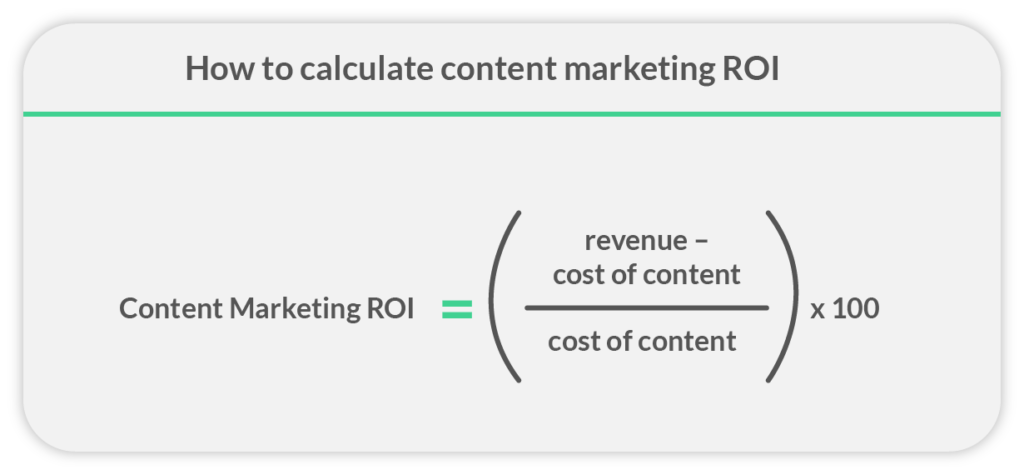A tough pill to swallow for many marketers is that the success of their content marketing campaigns can largely be determined by one metric – ROI. A campaign can achieve almost any number of objectives but if it doesn’t bring in more money than it cost, then it wasn’t a success.
In simple terms, content marketing ROI shows you how much revenue your campaign brought you against how much you spent. As a rule, the higher your ROI, the better. For example, if you have a £20,000 budget for your campaign and you bring in £35,000 then it had a 175% ROI. For every £1 that was spent on content marketing, you created £1.75 of revenue. No matter how you look at it, that’s a good investment.
Why measure ROI?
As you’ll have already figured out, measuring ROI is important as it allows you to honestly evaluate the success of your campaign. If you aren’t measuring it, you’ll never know which of your campaigns provide true value and which are losing you money. This is invaluable for long-term performance as it lets you refine your strategy based on previous experience and realise content marketing success. When you know what works and what doesn’t, you become a better content marketer.
Having a clear metric like ROI also provides you with more ammunition for those big business decisions. For in-house marketers, measuring ROI is useful for securing more budget from the C-suite or getting their buy-in on new initiatives. For agencies, it can be a valuable credential for securing new business and demonstrating value to existing customers. At Isoline, we’re very happy to have recently achieved a ~700% ROI for HB Reavis with our award-winning Future of Work campaign.
How to measure content marketing ROI
Ok, so how do you measure it? Here’s a simple formula:

Yes, really, that’s it. For example, let’s say:
- the content for one of your campaigns cost £20,000 to produce
- the campaign brought in £50,000 in revenue.
(50,000 – 20,000/ 20,000) * 100 = 150. That makes your ROI 150%.
Very straightforward, but there are a few complications.
How do you calculate the cost of your content?
The cost of your content has two components – production and distribution. When producing content there is one obvious cost, the salary of whoever produced that content. If they’re a full-time employee, either in-house or at an agency, it’s their salary pro rata for the time spent on producing the asset. This is why agencies often calculate hourly rates for their employees – it makes it much easier to calculate how much the time they spent on a piece of content is worth. If a freelancer produced the content, then you simply need to use their fee.
And, for distribution, you need to be just as diligent. Calculate your total spend on paid promotions such as PPC, social media or other channels. Usually, this is more straightforward as there are fewer hidden costs. Although it is still critical that you make sure to account for these hidden costs in both production and distribution, including work done by other departments, any outsourced work, any licensed images or software, and so on.
How do you calculate revenue from content?
This is where the real challenge lies in calculating content marketing ROI. And there are a few reasons:
- There isn’t always a clear link between which content led to which sales.
- There is often a delay between content being engaged with by customers and a sale.
- Customers often consume multiple pieces of content before a sale.
This isn’t always the case. In some instances, there is a direct call to action in a piece of content which makes it clear for sales teams where they came from. But, unfortunately, it’s generally not this easy.
Content marketing metrics by the numbers
For these assets where it’s not possible to directly measure the revenue generated, you can always do an estimate. And while this has some value, it’s simply not as reliable as concrete figures. For the purposes of getting buy-in from the C-suite or using it as credentials for driving new business, it’s simply not as reliable.
This is, again, where Google Analytics is invaluable. If you invest some time in uncovering the path customers are taking before they’re converted, you can figure out the precise value of each part of that journey. In other words, you can use conversion metrics to clearly track which customers engaged with which pieces of content before their sale. For a better idea of what metrics you should be tracking, take a look at my previous blog on the topic.
If you aren’t able to use Google Analytics, it will be hard to get these insights. If you can’t accurately measure ROI, there are other metrics you can track which are still valuable. Two particularly good ones to measure are lead quality and traffic. These can tell if your content marketing campaigns are attracting the right kinds of leads – from the right region, demographic and with the right intent – and what kind of success your content is having with audiences as a whole.
In summary, content marketing ROI can be tricky to measure. But it’s a worthwhile time investment that allows you to grow as a marketer, delivering better campaigns that bring more value. At Isoline, measuring campaign performance is at the heart of our approach to content marketing. To see what kind of results we get for our clients, why not get in touch?



